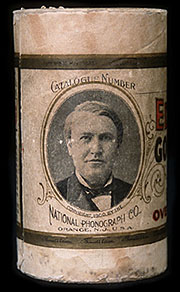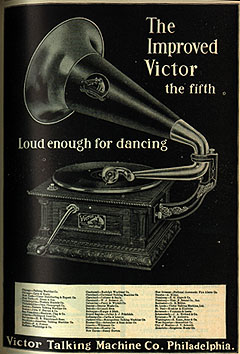|
Invented by Edison in the 1870s, the phonograph was originally marketed to
businesses as a dictating machine. At the beginning of the 1890s, however, America
discovered its entertainment uses. The first catalogue of the Columbia
Phonograph Company (1891) lists, in addition to musical selections by such
artists as Sousa and Foster, 20 "speaking records." That's the category the
two recordings here belong in. Both feature Len Spencer, one of the first stars
of this new media. According to Roland Gelatt, Spencer "specialized in Negro
songs interspersed with shouts, humorous asides, and touching sayings according
to the temper of the verse."* Here he performs two scenes derived from Uncle
Tom's Cabin: on this page, supported by orchestral accompaniment and sound effects for
the dogs and the whip, he performs "The Flogging Scene"; on the NEXT
PAGE, supported by a female vocalists, a banjo player and steamboat
sound effects, the "Entrance of Topsy."
He recorded the first piece twice in March 1904, once for Edison's company, and
once for the Victor Talking Machine Company. Both recordings would have been
made in a session like the one pictured above, with Spencer speaking
right into a horn, switching back and forth between Tom and Legree's voices,
with the orchestra gathered behind him. The recording process was acoustic, and
all the sound had to be captured simultaneously.
The Edison recording went onto a cylinder, the original form of the record,
which in 1904 limited the length to just over two minutes. In 1894 the flat disc became
available as an alternative to the cylinder, and in 1903 Victor introduced a
12-inch disc that increased the available length to three and a half minutes;
Spencer's "Flogging Scene" was released on a 10-inch disc, and lasts 40 seconds
longer than the Edison version. The script is actually the same, but with the
additional available time you can hear how Spencer slows down his delivery.
(You will have trouble hearing the Edison version at all; the cylinder was
damanged with bangs and tracking problems. But if you play the Victor version
first, you'll be able to follow the other one more easily.)
Edison and Victor were fierce competitors, so it's not clear why both brought out
this selection. Nor is it clear to me what contemporary listeners bought a
phonograph recording called "The Flogging Scene" to hear. Both versions end
with Legree's command to "Kill him!" (though we couldn't retrieve that phrase in
usable form from the cylinder), but the violence of this scene is gestured to more than
dramatized. |
3D
IMAGE (102KB)
3D
IMAGE (64KB)

Cylinder Case (c1904)
Edison Gold Moulded Records

Ad in Cosmopolitan
December 1903
|




